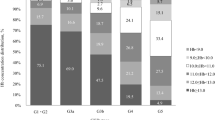Abstract
Background
The present study was aimed at investigating the factors related to hypo-responsiveness to erythropoietin in patients on chronic peritoneal dialysis (PD).
Methods
We studied 44 patients with end-stage renal disease who had been on PD for more than 6 months and on erythropoietin (EPO) ≥6,000 U/week for more than 3 months. We expressed EPO resistance index (ERI) as weekly EPO dose per hematocrit (Hct) per body weight. The dose of EPO was titrated to maintain a target Hct level between 33% and 36%. Patients were divided into two groups according to weekly EPO dose. We compared the various factors in those two groups and, by using correlation and linear regression analysis, investigated factors that might predict EPO resistance.
Results
There were 13 patients in the EPO <150 U/kg per week group and 31 patients in the EPO ≥150 U/kg per week group. Among those 31 patients, there were five patients on EPO ≥300 U/kg per week. Compared to the EPO <150 U/kg per week group, the EPO ≥150 U/kg per week group had a lower normalized protein catabolic rate (nPCR), lower level of serum albumin and higher C-reactive protein (CRP). Correlation analysis showed that the ERI had a statistically significant correlation with CRP (r = 0.303, P < 0.05), serum albumin (r = −0.26, P < 0.05), parathyroid hormone (PTH) (r = −0.307, P < 0.05) and nPCR (r = −0.259, P < 0.05). These results show that CRP, serum albumin, PTH and nPCR are factors related to hypo-responsiveness. Multiple stepwise linear regression analysis showed that CRP was the most important independent predictor of EPO hypo-responsiveness.
Conclusion
CRP, serum albumin, nPCR and PTH are factors related to hypo-responsiveness. Inflammation contributes significantly to EPO hypo-responsiveness.

Similar content being viewed by others
References
Eschbach JW, Egrie JC, Downing MR, et al (1987) Correction of the anemia of end-stage renal disease with recombinant human erythropoietin. Results of a combined phase I and II clinical trial. N Engl J Med 316(2):73–78
Gunnell J, Yeun JY, Depner TA, et al (1999) Acute-phase response predicts erythropoietin resistance in hemodialysis and peritoneal dialysis patients. Am J Kidney Dis 33(1):63–72
Macdougall IC (1995) Poor response to erythropoietin: practical guidelines on investigation and management. Nephrol Dial Transplant 10(5):607–614
Macdougall IC, Hutton RD, Cavill I, et al (1989) Poor response to treatment of renal anaemia with erythropoietin corrected by iron given intravenously. BMJ 299(6692):157–158
Stivelman JC (1989) Resistance to recombinant human erythropoietin therapy: a real clinical entity? Semin Nephrol 9[1 Suppl 2]:8–11
Van Wyck DB, Stivelman JC, Ruiz J, et al (1989) Iron status in patients receiving erythropoietin for dialysis-associated anemia. Kidney Int 35(2):712–716
Drueke T (2001) Hyporesponsiveness to recombinant human erythropoietin. Nephrol Dial Transplant 16[Suppl 7]:25–28
Kim JK, Park BS, Park MJ, et al (2001) The predictive parameters of erythropoietin hyporesponsiveness in patients on continuous ambulatory peritoneal dialysis. Korean J Intern Med 16(2):110–117
Smrzova J, Balla J, Barany P (2005) Inflammation and resistance to erythropoiesis-stimulating agents—what do we know and what needs to be clarified? Nephrol Dial Transplant 20[Suppl 8]:viii2–viii7
Locatelli F, Andrulli S, Memoli B, et al (2006) Nutritional-inflammation status and resistance to erythropoietin therapy in haemodialysis patients. Nephrol Dial Transplant 21(4):991–998
Eschbach JW, Kelly MR, Haley NR, et al (1989) Treatment of the anemia of progressive renal failure with recombinant human erythropoietin. N Engl J Med 321(3):158–163
Stenvinkel P (2001) The role of inflammation in the anaemia of end-stage renal disease. Nephrol Dial Transplant 16[Suppl 7]:36–40
Pajek J, Bucar-Pajek M, Grego K, et al (2005) Epoetin responsiveness in peritoneal dialysis patients: a multi-center Slovenian study. Ther Apher Dial 9(3):228–232
Amon O, Altrogge H, Kemper M, et al (1994) Increased need of erythropoietin during peritonitis in children on continuous peritoneal dialysis. Adv Perit Dial 10:318–320
Barany P, Divino Filho JC, Bergstrom J (1997) High C-reactive protein is a strong predictor of resistance to erythropoietin in hemodialysis patients. Am J Kidney Dis 29(4):565–568
Horl WH, Jacobs C, Macdougall IC, et al (2000) European best practice guidelines 14–16: inadequate response to epoetin. Nephrol Dial Transplant 15[Suppl 4]:43–50
Drueke TB (1995) R-HuEPO hyporesponsiveness—who and why? Nephrol Dial Transplant 10[Suppl 2]:62–68
Mandolfo S, Malberti F, Farina M, et al (1998) Parathyroidectomy and response to erythropoietin therapy in anaemic patients with chronic renal failure. Nephrol Dial Transplant 13(10):2708–2709
Lopez-Gomez JM, Perez-Flores I, Jofre R (2004) Presence of a failed kidney transplant in patients who are on hemodialysis is associated with chronic inflammatory state and erythropoietin resistance. J Am Soc Nephrol 15(9):2494–2501
Almond MK, Tailor D, Marsh FP, et al (1994) Increased erythropoietin requirements in patients with failed renal transplants returning to a dialysis programme. Nephrol Dial Transplant 9(3):270–273
Movilli E, Cancarini GC, Zani R, et al (2001) Adequacy of dialysis reduces the doses of recombinant erythropoietin independently from the use of biocompatible membranes in haemodialysis patients. Nephrol Dial Transplant 16(1):111–114
Kharagjitsingh AV, Dekker FW, Vandenbroucke JP (2004) Epoetin-induced pure red-cell aplasia Ned Tijdschr Geneeskd 148(51):2550–2553
Nakamoto H, Kanno Y, Okada H, et al (2004) Erythropoietin resistance in patients on continuous ambulatory peritoneal dialysis. Adv Perit Dial 20:111–116
Author information
Authors and Affiliations
Corresponding author
Rights and permissions
About this article
Cite this article
Wei, M., Bargman, J.M. & Oreopoulos, D.G. Factors related to erythropoietin hypo-responsiveness in patients on chronic peritoneal dialysis. Int Urol Nephrol 39, 935–940 (2007). https://doi.org/10.1007/s11255-007-9226-6
Received:
Accepted:
Published:
Issue Date:
DOI: https://doi.org/10.1007/s11255-007-9226-6




